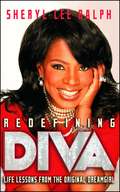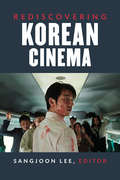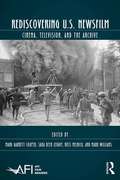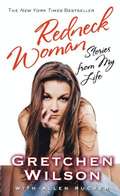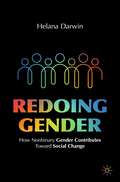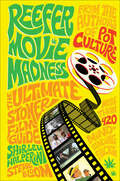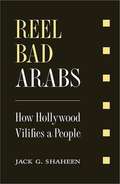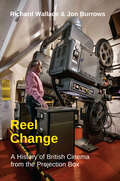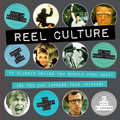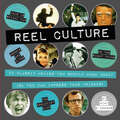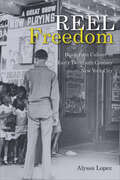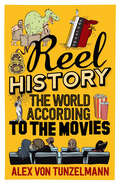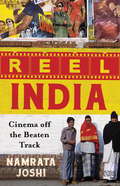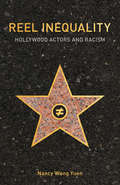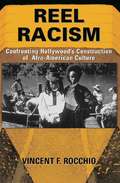- Table View
- List View
Redefining Diva: Life Lessons from the Original Dreamgirl
by Sheryl Lee RalphSecrets about love, life, and Hollywood from the Tony Award-winning actress from the Broadway production of Dreamgirls —in the role recently made famous by Beyonce—timed to coincide with the thirtieth anniversary of the original Broadway show.Sheryl Lee Ralph was the original Deena Jones in Broadway’s production of Dreamgirls and the show was a Broadway sensation from its inception. Now, the star of film, television, and Broadway, known for her talent and fearlessness, shows readers how to find—and own—their inner divas. Sheryl rose to international fame after her performance in Dreamgirls, winning the Tony Award for Best Actress and going on to star in movies with Denzel Washington and Robert DeNiro and capture America’s heart as television’s favorite mom Die in the #1-rated series Moesha . But it wasn’t an easy task. From her legendary catfight with Diana Ross to her controversial exit from Moesha, Sheryl Lee Ralph is a woman who does not fade in the background—and she reveals how and why she has remained in the spotlight for decades.Sheryl is a hip, modern Miss Manners who inspires women with her wit, strength, and call-it-like-it-is courage. Using her own experiences as a guide—and dishing the truth behind all the rumors—Sheryl reveals her rules for living. This is Divahood A-Z—from the practical to the spiritual, featuring advice on everything from relationships to fashion to success in the business world. So, the next time someone calls you a diva, you’ll just smile and say “Thank you!”
Rediscovering Korean Cinema (Perspectives On Contemporary Korea)
by Sangjoon LeeSouth Korean cinema is a striking example of non-Western contemporary cinematic success. Thanks to the increasing numbers of moviegoers and domestic films produced, South Korea has become one of the world’s major film markets. In 2001, the South Korean film industry became the first in recent history to reclaim its domestic market from Hollywood and continues to maintain around a 50 percent market share today. High-quality South Korean films are increasingly entering global film markets and connecting with international audiences in commercial cinemas and art theatres, and at major international film festivals. Despite this growing recognition of the films themselves, Korean cinema’s rich heritage has not heretofore received significant scholarly attention in English-language publications. This groundbreaking collection of thirty-five essays by a wide range of academic specialists situates current scholarship on Korean cinema within the ongoing theoretical debates in contemporary global film studies. Chapters explore key films of Korean cinema, from Sweet Dream, Madame Freedom, The Housemaid, and The March of Fools to Oldboy, The Host, and Train to Busan, as well as major directors such as Shin Sang-ok, Kim Ki-young, Im Kwon-taek, Bong Joon-ho, Hong Sang-soo, Park Chan-wook, and Lee Chang-dong. While the chapters provide in-depth analyses of particular films, together they cohere into a detailed and multidimensional presentation of Korean cinema’s cumulative history and broader significance. With its historical and critical scope, abundance of new research, and detailed discussion of important individual films, Rediscovering Korean Cinema is at once an accessible classroom text and a deeply informative compendium for scholars of Korean and East Asian studies, cinema and media studies, and communications. It will also be an essential resource for film industry professionals and anyone interested in international cinema.
Rediscovering U.S. Newsfilm: Cinema, Television, and the Archive (AFI Film Readers)
by Mark Williams Ross Melnick Mark Garrett Cooper Sara Beth LevavyThe twentieth century generated tens of thousands of hours of American newsfilm but not the scholarly apparatus necessary to analyze and contextualize them. Assembling new approaches to the study of U.S. newsfilm in cinema and television, this book makes a long overdue critical intervention in the field of film and media studies by addressing the format’s inherent intermediality; its mediation of "events" for local, national, and transnational communities; its distinctive archival legacies; and, consequently, its integral place in film and television studies more broadly. This collection brings fresh, contemporary methodologies and analysis to bear on a vast amount of material that has languished in relative obscurity for far too long.
Redneck Boy in the Promised Land: The Confessions of Crazy Cooter
by Ben JonesRedneck Boy in the Promised Land is Ben Jones's hilarious, uplifting life story of escaping the rail yards and finding success in the unlikeliest places. As a child, Jones called a dingy railroad shack with no electricity or indoor plumbing home. An unabashed Southern redneck from a "likker drinkin', hell-raisin'" family, Jones grew up in the depressed railroad docks outside of Portsmouth, Virginia, and spent most of his days dreaming about where the tracks out of town could take him. That he would go on to become a beloved television icon on The Dukes of Hazzard and a firebrand two-term Congressman is a story that no one could have ever seen coming, least of all ol' "Cooter" himself. Written with naked honesty and wry humor, Redneck Boy in the Promised Land is one good ol' boy's remarkable tale of falling flat on his face, picking himself up, and finding his way to the American dream--while fighting for civil rights, the plight of the working class, "real" Southern culture, and the rights of rednecks everywhere.
Redneck Woman: Stories from My Life
by Allen Rucker Gretchen WilsonRaised by a single mom in rural Illinois, Gretchen Wilson's formal education concluded in the eighth grade when she traded books for tending bar at Big O's, a rough-and-tumble joint on the outskirts of Pocahontas, IL. By the time she was 15, Gretchen was managing the place with the help of a loaded 12-gauge behind the bar to keep folks in line. Though he was long gone, Wilson's father had instilled a love of music in his daughter that blossomed on stage at Big O's where she found herself fronting a cover band and eyeing a move to Nashville in search of something more. Another town, struggling in another bar job, but again her gift for music won out. Discovered while singing with the house band at a bar in Nashville's famed Printer's Alley, Gretchen Wilson soon joined the ranks of the Muzik Mafia and the rest is history. In less than one calendar year she went from worrying about the repossession of her car to being one of the most successful recording stars in the world. Co-written by acclaimed and New York Times bestselling author Allen Rucker, the book will cover this inspiring All-American success story while providing a fun, and insightful look in on the kind of strength, will, and humor that have allowed Wilson to reclaim the term "Redneck" and recast it as a point of pride for millions of her fans. Whether she discusses her fashion preferences (Wal-Mart over Victoria's Secret), her choice of beer over champagne, her views on family, or the artists who've helped her to carve out the path she currently walks (Tammy Wynette, Loretta Lynn, Merle Haggard, etc.), Wilson's signature knack for storytelling and connecting with her audience on that authentically real level translates seamlessly to the page and offers a new and exciting glimpse at one of America's most beloved performers.
Rednecks, Queers, and Country Music
by Nadine HubbsIn her provocative new book Rednecks, Queers, and Country Music, Nadine Hubbs looks at how class and gender identity play out in one of America's most culturally and politically charged forms of popular music. Skillfully weaving historical inquiry with an examination of classed cultural repertoires and close listening to country songs, Hubbs confronts the shifting and deeply entangled workings of taste, sexuality, and class politics. In Hubbs's view, the popular phrase "I'll listen to anything but country" allows middle-class Americans to declare inclusive "omnivore" musical tastes with one crucial exclusion: country, a music linked to low-status whites. Throughout Rednecks, Queers, and Country Music, Hubbs dissects this gesture, examining how provincial white working people have emerged since the 1970s as the face of American bigotry, particularly homophobia, with country music their audible emblem. Bringing together the redneck and the queer, Hubbs challenges the conventional wisdom and historical amnesia that frame white working folk as a perpetual bigot class. With a powerful combination of music criticism, cultural critique, and sociological analysis of contemporary class formation, Nadine Hubbs zeroes in on flawed assumptions about how country music models and mirrors white working-class identities. She particularly shows how dismissive, politically loaded middle-class discourses devalue country's manifestations of working-class culture, politics, and values, and render working-class acceptance of queerness invisible. Lucid, important, and thought-provoking, this book is essential reading for students and scholars of American music, gender and sexuality, class, and pop culture.
Redoing Gender: How Nonbinary Gender Contributes Toward Social Change
by Helana DarwinRedoing Gender demonstrates how difficult it is to be anything other than a man or a woman in a society that selectively acknowledges those two genders. Gender nonbinary people—who identify as other genders besides simply “man” or “woman”—have begun to disrupt this binary system, but the limited progress they have made has required significant everyday labor. Through interviews with 47 nonbinary people, this book offers rich description of these forms of labor, including “rethinking sex and gender,” “resignifying gender,” “redoing relationships,” and “resisting erasure.” The final chapter interrogates the lasting impact of this labor through follow-up interviews with participants four years later. Although nonbinary people are finally managing to achieve some recognition, it is clear that this change has not happened without a fight that continues to this day. The diverse experiences of nonbinary people in this book will help cisgender people relate to gender minorities with more compassion, and may also appeal to those questioning their own gender. This text will also be of keen interest to academics across Sociology and Gender Studies.
Redwing
by Holly BennettRowan is the sole survivor when his entire family is struck down by the plague. Alone and grief-stricken, Rowan ekes out a living by playing music on his button box in the small towns and villages of Prosper. He lives and travels in his family's old caravan, half starved and in despair. One day, he finds he has competition: a young man playing a violin. Rather than make an adversary, Rowan suggests they travel and play together, but he regrets his offer when he finds out that Samik is from the Tarzine Lands, beyond the volcanoes, and is being pursued by a vengeful warlord. And that's not all. Samik also claims to have the Sight - and what he sees (and hears) is Rowan's dead sister, Ettie. As they travel from town to town, they form an uneasy alliance, which gradually evolves into a friendship that will be tested to its limits when Samik is captured.
Reefer Movie Madness: The Ultimate Stoner Film Guide
by Steve Bloom Shirley HalperinThe ultimate guide for bong-hitting movie buffs, with over 420 entries—plus contributions from Snoop Dogg, Cheech & Chong, Margaret Cho, and more.From the authors of Pot Culture, Reefer Movie Madness is the most extensive guide ever to movies for and about stoners, going well beyond Harold and Kumar and Pineapple Express. In addition to entries on more than 420 films, there are contributions and Q&As from actors, movie directors, musicians, and celebrities, including Jason Mraz, comedian Andy Milonakis, Snoop Dogg, Doug Benson, and Cheech & Chong. Reefer Movie Madness covers it all, from pot-fueled comedies and druggy dramas to sci-fi flicks and 1960s artifacts to documentaries, musicals, and blockbusters—including lots of photos, sidebars, and lists.
Reel Asian: Asian Canada on Screen
by Elaine ChangFounded in 1997 by producer Anita Lee and journalist Andrew Sun, the Toronto Reel Asian International Film Festival is a unique showcase of contemporary Asian cinema and work from the Asian diaspora. The festival fosters the exchange of cultural and artistic ideals between East and West, provides a public forum for homegrown Asian media artists and their work and fuels the growing appreciation for Asian cinema in Canada.In Reel Asian: Asian Canada on Screen, contributors, many of them filmmakers, examine East and Southeast Asian Canadian contributions to independent film and video. This collection highlights the screen as a site for the reflection, projection and reimagination of identities and communities, and explores the idea that Asian Canada is less a demographic category than it is a term of art. Distinguished film- and video-makers, artists and cultural critics address a wide array of topics, genres, regional concerns and historical contexts in provocative, original essays and one-on-one conversations. The first anthology of its kind, the volume also includes a substantial selection of images and stills, and a resources section providing detailed artist and distribution information.
Reel Bad Arabs: How Hollywood Vilifies a People
by Jack G. ShaheenA groundbreaking book that dissects a slanderous history dating from cinema's earliest days to contemporary Hollywood blockbusters that feature machine-gun wielding and bomb-blowing "evil" Arabs.
Reel Change: A History of British Cinema from the Projection Box
by Richard Wallace Jon BurrowsTen years ago, a technological revolution swept through cinemas around the world, as analogue projectors were replaced with digital equipment. It was not just the plastic medium of film that was removed from projection boxes during this transformation; most cinemas took this opportunity to also evict the human projectionists who were hitherto in charge of screenings. Projectionists had been hidden from the sight of audiences for most of the history of photographic moving image projection, and their redundancies went largely unnoticed and unremarked upon. This book focuses attention on what has been happening behind film spectators' heads for the past 130 years, and attempts to write the history of cinema in Britain from the perspective of its habitually overlooked and undervalued projectionists, beginning in the silent era and continuing to the present day. Drawing upon extensive archival research and lengthy interviews with former projectionists, it documents the key facets and challenges of their work, and how these evolved in response to previous waves of significant technological change. It evaluates how projectionists helped to design and maintain key aesthetic characteristics of the 20th century big screen experience. It shows how the institution of cinema in Britain has been historically underpinned by the harsh exploitation of projectionists by many employers, detailing inadequate wage levels and poor working conditions that formerly provoked government investigation, and explaining why these problems were never successfully ameliorated by trade unions. It also charts in depth the recent fateful transition to digital projection, delineating how and why projectionists were so swiftly and ruthlessly consigned to the past, and assessing whether this form of entertainment should be considered diminished by their super session.
Reel Culture
by Mimi O'ConnorTeens love movies. But when we start talking about the movies from last century, they're often in the dark. Reel Culture is for the young person who is curious about film history, and wants to be the one at the party who knows what Casablanca was about or who first made the LBD (little black dress) hot in Breakfast at Tiffany's. From Willy Wonka and the Chocolate Factory to Raiders of the Lost Ark, Reel Culture explores the 50 most influential--yet often unknown to teens--films of the 20th century.
Reel Culture: 50 Movies You Should Know About (So You Can Impress Your Friends)
by Mimi O'ConnorReel Culture is for the young person who is curious about film history and wants to be the one at the party who knows what Casablanca was about or who made the LBD (little black dress) hot in Breakfast at Tiffany's. From Willy Wonka and the Chocolate Factory to Raiders of the Lost Ark, Reel Culture explores the 50 most influential—yet often unknown to teens—films of the 20th century.
Reel Food: Essays on Food and Film
by Anne L. BowerFirst published in 2005. Routledge is an imprint of Taylor & Francis, an informa company.
Reel Freedom: Black Film Culture in Early Twentieth-Century New York City (Urban Life, Landscape and Policy)
by Alyssa LopezReel Freedom intimately captures the relationship between Black film culture and space in New York City. Alyssa Lopez argues that Black film culture, from its origins in the early twentieth century to its firm establishment in the 1930s, was necessarily both entertainment and resistance, connected as it was to Black New Yorkers’ demands for access and equality in the city. Lopez investigates how ordinary people, labor activists, journalists, filmmakers, theater managers, and owners all shaped Black film culture. Black girls and women used moviegoing as a means of independence and control over their lives. Race filmmaker Oscar Micheaux fought with New York State’s censorship board to get his films screened with limited edits in local theaters. And Harlem’s Black projectionists battled for unionization and fair pay, while journalists linked cinema to Black New Yorkers’ lived experiences. In Reel Freedom, Lopez chronicles the wide-ranging and remarkable pervasiveness of Black film culture in New York City, redefining a period and place most associated with the Harlem Renaissance. In doing so, she illustrates how Black New Yorkers leveraged cinema to make the city their own and to enjoy urban living to its fullest. In the series Urban Life, Landscape, and Policy
Reel History: The World According to the Movies
by Alex Von TunzelmannFrom ancient Egypt to the Tudors to the Nazis, the film industry has often defined how we think of the past. But how much of what you see on the screen is true? Picking her way through Hollywood's version of events, an acclaimed historian sorts fact from fiction. Based on the long-running column in the Guardian, Reel History takes a comic look at the history of the world as told through the movies—the good, the bad, and the very, very ugly.
Reel India: Cinema off the Beaten Track
by Namrata Joshi‘Picture abhi baaki hai…’ If there’s one experience that unites India, it is cinema. In Reel India, award-winning film critic Namrata Joshi journeys through the interiors of the country intimately chronicling little-known accounts about the nation’s incessant obsession with the movies. In Lucknow, she encounters a Shah Rukh Khan fan who has embraced an alternate reality in which he lives and breathes the star. In Wai, she finds an entire economy fuelled by the film industry as the town transforms into a film set. An activist filmmaker in Odisha demonstrates how he teaches local tribal people the basics of his craft, empowering them to train the spotlight on issues threatening their habitat and livelihood. From the fever pitch of the ‘first day first show’ in makeshift halls to the rivalries of regional cinema, this is India’s immersion in the movies like it’s never been seen before. Filled with real-life stories that are as fascinating as the revelations and insights they offer, Reel India raises the curtain on the starry-eyed dreams and big-screen passions that live on after the final ‘cut’ is announced.
Reel Inequality: Hollywood Actors and Racism
by Nancy Wang YuenWhen the 2016 Oscar acting nominations all went to whites for the second consecutive year, #OscarsSoWhite became a trending topic. Yet these enduring racial biases afflict not only the Academy Awards, but also Hollywood as a whole. Why do actors of color, despite exhibiting talent and bankability, continue to lag behind white actors in presence and prominence? Reel Inequality examines the structural barriers minority actors face in Hollywood, while shedding light on how they survive in a racist industry. The book charts how white male gatekeepers dominate Hollywood, breeding a culture of ethnocentric storytelling and casting. Nancy Wang Yuen interviewed nearly a hundred working actors and drew on published interviews with celebrities, such as Viola Davis, Chris Rock, Gina Rodriguez, Oscar Isaac, Lucy Liu, and Ken Jeong, to explore how racial stereotypes categorize and constrain actors. Their stories reveal the day-to-day racism actors of color experience in talent agents’ offices, at auditions, and on sets. Yuen also exposes sexist hiring and programming practices, highlighting the structural inequalities that actors of color, particularly women, continue to face in Hollywood. This book not only conveys the harsh realities of racial inequality in Hollywood, but also provides vital insights from actors who have succeeded on their own terms, whether by sidestepping the system or subverting it from within. Considering how their struggles impact real-world attitudes about race and diversity, Reel Inequality follows actors of color as they suffer, strive, and thrive in Hollywood.
Reel Kabbalah: Jewish Mysticism and Neo-Hasidism in Contemporary Cinema
by Brian OgrenReel Kabbalah: Jewish Mysticism and Neo-Hasidism in Contemporary Cinema studies the ways in which fictional film in the first decade of the twenty-first century represents the esoteric Jewish speculative traditions known as Kabbalah and Hasidism. It examines the textual and conceptual traditions behind five important cinematic representations -- Pi (1998), Ushpizin (2004), Bee Season (2005), The Secrets (2007), and A Serious Man (2009) -- and it considers how film both stands in continuity with those traditions and modifies them in the New Age vein of what is known as neo-Kabbalah and neo-Hasidism. Brian Ogren transforms our understanding of reception history by focusing on how cinema has altered perceptions of Jewish mysticism. In showing how the Jewish speculative traditions of Kabbalah and Hasidism have been able to affect mass-consumed cinematic portrayals of ultimate Truth, this book sheds light on the New Age, pop-cultural dialectic of the particular within the universal and of the universal within the particular.
Reel Racism
by Vincent F. RocchioReel Racism: Confronting Hollywood's Construction of Afro-American Culture goes beyond reflection theories of the media to examine cinema's active participation in the operations of racism --a complex process rooted in the dynamics of representation. Written for undergraduates and graduate students of film studies and philosophy, Reel Racism focuses on methods and frameworks that analyze films for their production of meaning and how those meanings participate in a broader process of justifying, naturalizing, or legitimizing difference, privilege, and violence based on race. In addition to analyzing how the process of racism is articulated in specific films, Reel Racism examines how specific meanings can resist their function of ideological containment, and instead, offer a perspective of a more collective, egalitarian social system-- one that transcends the discourse of race.
Reel Racism
by Vincent F. RocchioReel Racism: Confronting Hollywood's Construction of Afro-American Culture goes beyond reflection theories of the media to examine cinema's active participation in the operations of racism --a complex process rooted in the dynamics of representation. Written for undergraduates and graduate students of film studies and philosophy, Reel Racism focuses on methods and frameworks that analyze films for their production of meaning and how those meanings participate in a broader process of justifying, naturalizing, or legitimizing difference, privilege, and violence based on race. In addition to analyzing how the process of racism is articulated in specific films, Reel Racism examines how specific meanings can resist their function of ideological containment, and instead, offer a perspective of a more collective, egalitarian social system-- one that transcends the discourse of race.
Reel Racism
by Vincent F. RocchioReel Racism: Confronting Hollywood's Construction of Afro-American Culture goes beyond reflection theories of the media to examine cinema's active participation in the operations of racism --a complex process rooted in the dynamics of representation. Written for undergraduates and graduate students of film studies and philosophy, Reel Racism focuses on methods and frameworks that analyze films for their production of meaning and how those meanings participate in a broader process of justifying, naturalizing, or legitimizing difference, privilege, and violence based on race. In addition to analyzing how the process of racism is articulated in specific films, Reel Racism examines how specific meanings can resist their function of ideological containment, and instead, offer a perspective of a more collective, egalitarian social system-- one that transcends the discourse of race.
Reel Racism
by Vincent F. RocchioFor undergraduates and graduate students of film and media studies and philosophy, an analysis of mainstream cinema's participation in societal racism. Rocchio (film studies, Dartmouth) analyzes how films produce meaning and how those meanings in turn lead to a broad process of justifying, naturalizing, or legitimizing difference, privilege, and violence based on race. The text grew out of a series of lectures Rocchio developed for a course on racism and representation at St. John's U. , Queens. Annotation c. Book News, Inc. , Portland, OR (booknews. com)
